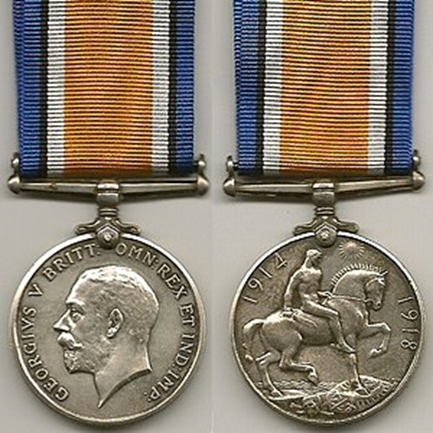John Francis Kilgariff
14 August 1890 – 25 July 1955
My maternal grandfather enlisted
and served in WW1 with the Royal Irish Rifles and Royal Irish Fusiliers as part
of the UK military, 7 August 1914 to 1 August 1919. He was an Irish citizen at
the time, living in Belfast with his parents and siblings.
John Francis Kilgariff, Royal Irish
Fusiliers (the emblem on his cap).
The chevrons on his right sleeve indicate
this photo was probably taken in Egypt towards the end of his service since one
chevron = one year of service overseas.
Photo from the private collection of
granddaughter Carol McLaughlin Neilson
He served in the War in the Balkans, including service in Gallipoli, and later in Palestine.
My grandfather’s military papers say he volunteered early in the war, with the Irish Rifles. According to my cousin Chris King, they would have been part of the 6th (Service) Battalion which was formed in Dublin in August 1914, and went through these evolutions and battles:
-Unit attached to 29th Brigade in the 10th (Irish) Division
-February 1914: moved to the Curragh
(a flat, open plain in County Kildare used by the military as a training camp)
-May 1915: moved to Hackwood Park
(Basingstoke) in Hampshire, UK, to continue military training
-7 July 1915: embarked at
Liverpool and sailed to Gallipoli via Mudros. Mudros was on the island of
Lemnos in the Aegean Sea (see above).
-29 September 1915: moved to
Salonika, arriving 4-5 October.
[-31 October 1916: My
grandfather was wounded; recuperated through at least December 1916; perhaps
longer.]
-September 1917: moved to Egypt
for service in Palestine
-15 May 1918: unit disbanded at
Deir-el-Nidham, Palestine
-1 August 1919: Demobilized, transferred to Reserve
Info from:
According to his Casualty Card extract [Fig 1] he was wounded 31 October 1916. No full casualty record is available due to WWII bombings of London. But the casualty card extract does tell the places he went when wounded. I put the events in chronological order and added additional information here to make it more understandable.
31 Oct 1916 - Wounded 31 October Reported by ob Battalion
2 Nov 1916 - Sto abdomen admitted 1st Canadian Stationary Hospital [on Lemnos, Greece]
(I don’t know why the 2 Nov incident appears before the 31 Oct incident on the card?)
6 Nov 1916 - Transferred to Hospital Ship Braemar Castle 6 November 1916 [Fig 2] a week later the ship struck a mine in the Aegean Sea
11 Nov 1916 - Sto R Thigh Admitted Admiral Baviere Military Hospital, Malta [Fig 3]
18 Dec 1916 - G Sto R Thigh transferred to Convalescent Camp Ghain Tuffieha, Malta [Fig 4]
Fig 1 - John Kilgariff's Casualty
Card. From Ancestry.com
Fig 2 – the Braemar Castle as a hospital ship - https://bandcstaffregister.com/page197.html - accessed 16Mar2023
This is the ship that transported my wounded grandfather to
the island of Malta, to recuperate. A week later this ship struck a mine and
exploded.
Fig 3 - https://en.wikipedia.org/wiki/Auberge_de_Bavi%C3%A8re accessed 16Mar2023
The hospital where he recuperated,
on the east side of Malta (blue pinpoint).
FIG 54- http://www.maltaramc.com/imgmaps/mltahosp1915.jpg accessed 17Mar2023
Convalescent Camp Ghain Tuffieha on Malta, location circled
in yellow, where he went to convalesce.
In 1917 his unit moved to Palestine for service in that region. At one point during his time in Palestine, he participated in celebrating the Feast Assumption of Our Lady on 15 August 1918. He saved a pamphlet of it, below.
Release from the military
1 August 1919. Certificate from ancestry.com
As a result of his service in the military he was awarded three medals, shown on the next page.
Front: shows the King George V, bareheaded coinage effigy, facing left, with the legend:
GEORGIVS V BRITT : OMN : REX ET IND : IMP :
Reverse: there is a horseman, St. George, armed with a short sword (an allegory of the physical and mental strength which achieves victory over Prussianism). The horse tramples on the Prussian shield and the skull and cross-bones. Off-center, near the right upper rim, is the sun of Victory. The dates 1914 and 1918 appear in the left and right fields respectively.

British Victory Medal British 1915 Star For all who served in a theater of war before 1914
For further information on the Irish in WW1 in the Balkans:
For further information on the 6th (Service)
Battalion:
https://www.nickmetcalfe.co.uk/the-evolution-of-the-regular-and-service-battalions-of-princess-victorias-royal-irish-fusiliers-1914-1918-part-4-the-5th-6th-5th6th-11th-service-battalions/
For further information on the 10th (Irish) Division in WWI:
https://archive.org/details/tenthirishdivisi00cooprich
for further information on experiences of British soldiers in Egypt and Palestine:
http://ndl.ethernet.edu.et/bitstream/123456789/68411/1/23.pdf.pdf



















No comments:
Post a Comment